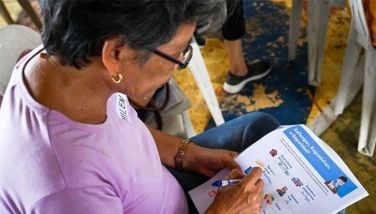Salvage victims were mostly criminals and hoodlums — police
November 29, 2006 | 12:00am
Victims of summary executions, or "salvaging" in police and media parlance, were criminals or people involved in illegal activities, an analysis released by the Manila Police District (MPD) showed.
Salvage victims were killed for vengeance either for violating a crime syndicate’s code of silence or for defying the gang leaders, the study released by the MPD’s homicide division, headed by Chief Inspector Alejandro Yanquiling Jr. showed
Between Sept. 11 and Nov. 21, the homicide section reported five victims of alleged salvaging, four of them found in the Pasig River.
Investigation showed most of the victims sustained stab wounds. Their faces were wrapped with masking tape and their feet and hands bound with plastic rope.
Three of the victims were identified as Mario Villones, of Quiapo; Michael Pineda, of Sta. Mesa; and Ernesto Punzalan. All three had criminal records for robbery, snatching, assault and theft.
The five suspected salvage victims had tattoos, indicating that they were criminal gang members, according to investigators.
Yanquiling said the manner of the executions of the victims were similar — they were killed and tortured in secluded areas and their bodies dumped in the river.
Punzalan’s body, however, was placed in a sack but bore no sign of physical torture. Yanquiling said this could mean that the victim had close ties with the suspects who chose not to prolong his agony.
Yanquiling said the "executioners" employed the same method of killing.
The victims’ faces and mouths were covered with masking tape to suffocate them in case they survived the stabbing. Their bodies were thrown into the river most likely in an attempt to mislead investigators from finding the exact place where the victims were killed.
Yanquiling believes the salvagings were meant to send a strong signal to "undisciplined" gang members that they would suffer the same fate unless they toed the line.
The homicide section chief said that although it is difficult to pinpoint the perpetrators of salvaging — which he said could also be perpetrated by rogue police officers, soldiers and vigilante groups — the style and similarities of execution provided clues about the suspects.
In the cases of the two unidentified victims, police are eyeing the possible involvement of drug syndicates in Quiapo’s Muslim community which are notorious for executing double-crossers or police informants.
The bodies of the two victims were retrieved from the Pasig River near the community, according to police. – Nestor Etolle
Salvage victims were killed for vengeance either for violating a crime syndicate’s code of silence or for defying the gang leaders, the study released by the MPD’s homicide division, headed by Chief Inspector Alejandro Yanquiling Jr. showed
Between Sept. 11 and Nov. 21, the homicide section reported five victims of alleged salvaging, four of them found in the Pasig River.
Investigation showed most of the victims sustained stab wounds. Their faces were wrapped with masking tape and their feet and hands bound with plastic rope.
Three of the victims were identified as Mario Villones, of Quiapo; Michael Pineda, of Sta. Mesa; and Ernesto Punzalan. All three had criminal records for robbery, snatching, assault and theft.
The five suspected salvage victims had tattoos, indicating that they were criminal gang members, according to investigators.
Yanquiling said the manner of the executions of the victims were similar — they were killed and tortured in secluded areas and their bodies dumped in the river.
Punzalan’s body, however, was placed in a sack but bore no sign of physical torture. Yanquiling said this could mean that the victim had close ties with the suspects who chose not to prolong his agony.
Yanquiling said the "executioners" employed the same method of killing.
The victims’ faces and mouths were covered with masking tape to suffocate them in case they survived the stabbing. Their bodies were thrown into the river most likely in an attempt to mislead investigators from finding the exact place where the victims were killed.
Yanquiling believes the salvagings were meant to send a strong signal to "undisciplined" gang members that they would suffer the same fate unless they toed the line.
The homicide section chief said that although it is difficult to pinpoint the perpetrators of salvaging — which he said could also be perpetrated by rogue police officers, soldiers and vigilante groups — the style and similarities of execution provided clues about the suspects.
In the cases of the two unidentified victims, police are eyeing the possible involvement of drug syndicates in Quiapo’s Muslim community which are notorious for executing double-crossers or police informants.
The bodies of the two victims were retrieved from the Pasig River near the community, according to police. – Nestor Etolle
BrandSpace Articles
<
>
- Latest
- Trending
Trending
Latest
Trending
Latest
Recommended


















